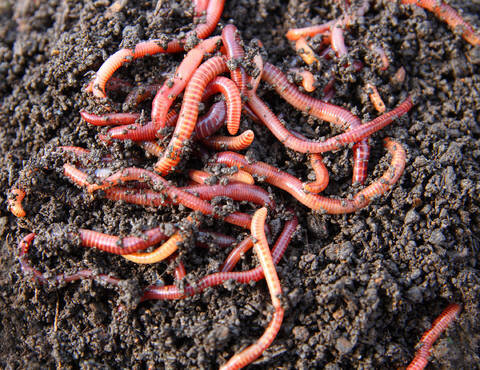Red wigglers: For worm bins
Red wigglers: For worm bins
Blog Article
The Ultimate Guide to Red Wigglers for Healthy Dirt
The function of red wigglers, scientifically known as Eisenia fetida, in dirt health and wellness is a topic of raising interest among sustainable gardening fanatics and agricultural professionals alike. These microorganisms not just reuse natural waste yet additionally enhance soil fertility with their nutrient-rich castings.
What Are Red Wigglers?
Red wigglers, scientifically referred to as Eisenia fetida, play a critical function in composting and dirt wellness. These earthworms are specifically appropriate for vermicomposting, a process that uses their natural behaviors to break down organic issue effectively. Unlike various other earthworm varieties, red wigglers prosper in rich natural atmospheres, making them perfect for garden compost containers and worm ranches.
Measuring regarding three to four inches in size, red wigglers possess an unique reddish-brown coloration and a fractional body that aids in their wheelchair with rotting materials. They are detritivores, meaning they prey on rotting natural materials, consisting of kitchen scraps, plant particles, and paper products. red worms. With their consumption of these materials, they help break down intricate compounds, turning them into nutrient-rich spreadings that enhance dirt top quality
Red wigglers are additionally respected breeders, with the ability of recreating quickly under optimal conditions. Their flexibility to different environments permits them to flourish in a variety of composting systems. By understanding the biology and environmental value of red wigglers, garden enthusiasts and farmers can harness their capabilities to boost soil health and advertise sustainable techniques in farming.

Benefits of Red Wigglers
The countless benefits of including red wigglers into composting practices considerably enhance soil health and fertility. These earthworms, medically recognized as Eisenia fetida, excel at damaging down raw material, changing kitchen area scraps and yard waste into nutrient-rich vermicompost. This procedure not only speeds up decay however additionally enriches the dirt with vital nutrients such as nitrogen, phosphorus, and potassium.
In addition, red wigglers boost dirt framework by producing accumulations that assist in aeration and water retention. Their burrowing tasks promote a well-aerated atmosphere, allowing origins to access oxygen much more effectively. This improved aeration additionally fosters valuable microbial activity, which is important for nutrient cycling and total soil vitality.
Along with boosting dirt make-up and framework, red wigglers add to pest administration. Their existence in the dirt helps reduce unsafe nematodes and various other bugs, lowering the demand for chemical treatments. The application of vermicompost leads to raised plant strength versus illness, advertising healthier development.
Establishing a Worm Container
Establishing a worm bin can be a rewarding undertaking for those wanting to boost their composting efforts. The very first step is choosing a proper container, preferably made from plastic or wood, with a capability of at least 10 gallons to fit the worms and their food. Guarantee the container has ample air flow-- pierce little openings in the lid and sides visit the site to promote airflow while avoiding excess wetness accumulation.

Introduce the red wigglers into the bin, permitting them to accommodate to their brand-new environment. Ideally, start with a population of regarding one pound of worms per square foot of surface location. Lastly, place the worm bin in a place that maintains a secure temperature, preferably in between 55 ° F and 77 ° F. With these fundamental actions, your worm container will prepare to thrive in the pursuit of healthy soil.
(purchase red worms)
Feeding Your Red Wigglers
When it comes to supporting red wigglers, recognizing their dietary demands is important for preserving a healthy worm container. These worms grow on a varied diet plan, largely composed of natural matter.
Portion control is crucial; overfeeding can lead to odor issues and attract parasites. A great policy of thumb is to supply food that is approximately equivalent to the weight of the worms in the bin each week. Monitor the intake price and change feeding quantities as necessary.
To advertise a well balanced diet, goal to offer a mix of nitrogen-rich eco-friendlies, such as vegetable peels, and carbon-rich browns, such as dried leaves or cardboard. Additionally, maintaining appropriate dampness levels is essential-- food scraps must perspire yet not soaked - red worms. By meticulously managing their diet plan and atmosphere, you will certainly make certain that your red wigglers continue to be healthy and efficient, adding successfully to the composting process
Utilizing Worm Spreadings in Dirt
Integrating worm castings into soil can significantly enhance its wellness and fertility. Worm spreadings, also called vermicompost, are an abundant source of nutrients, including nitrogen, phosphorus, and potassium, vital for plant growth. When included in soil, these spreadings improve its structure by enhancing oygenation and boosting moisture retention, which is especially helpful in dry regions.
Furthermore, worm spreadings present useful microorganisms that advertise a healthy and balanced soil community (red worms). These microorganisms help in damaging down organic matter, making nutrients much more conveniently offered to plants. The existence of these germs additionally helps suppress soil-borne diseases, decreasing the demand for chemical plant foods and chemicals
To make use of worm castings successfully, mix them into the leading few inches of soil before growing or apply them as a leading dressing around established plants. A suggested application price is about 10-20% spreadings mixed with dirt to enhance vitamins and mineral availability without frustrating the plants.
Conclusion
In verdict, red wigglers, or Eisenia fetida, play a pivotal role in improving dirt health with their vermicomposting tasks. Inevitably, the assimilation of red wigglers into soil administration approaches promotes lasting farming by lowering dependency on chemical fertilizers and promoting valuable microbial task.
Report this page